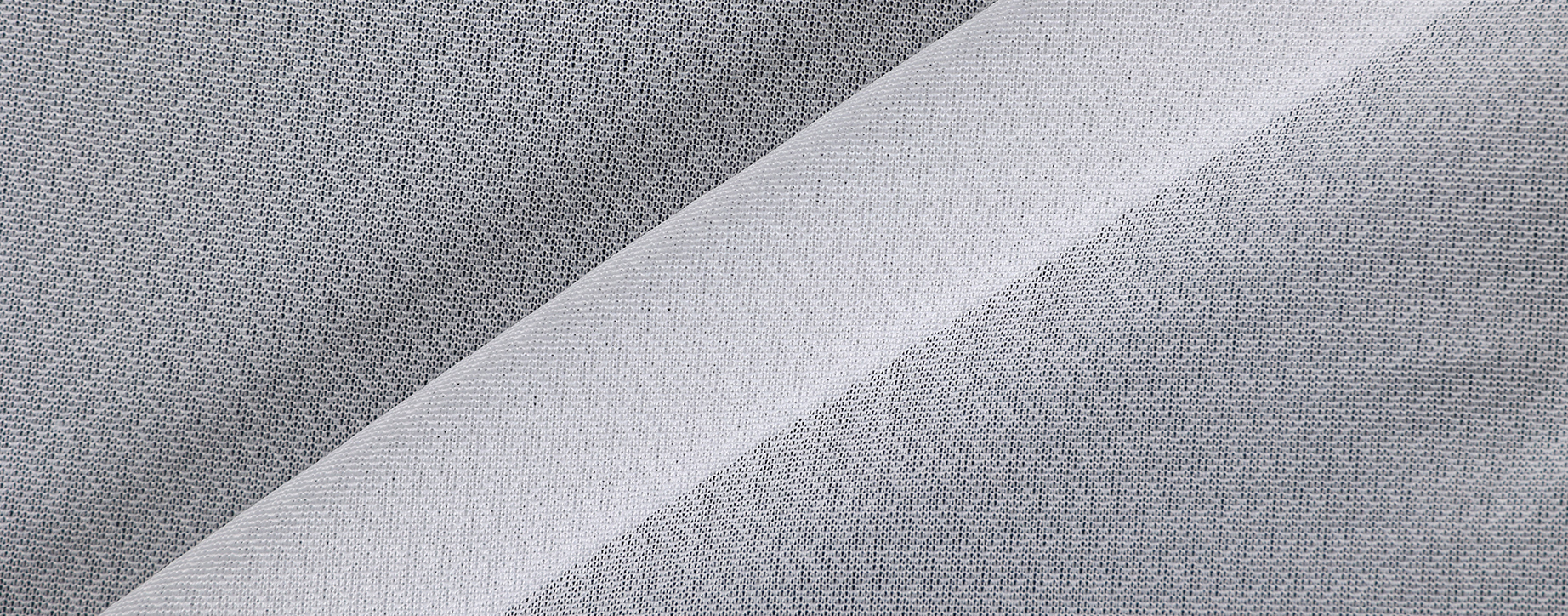Enhancing Every Garment
This series is made using low-elastic semi-gloss DTY and woven with circular knitting. The fabric is finished with high-temperature dyeing, providing excellent elasticity and comfort.
This production adopt advanced double dot coating technique.Using high-performance PA adhesive powder.It has a good performance after dry and water washing.
It widely suits for all kinds of elastic woven, knitted fabrics.
It is suitable for the front parts,collar,sleeve,waistband,placket,pocketing and reinforcement parts of jacket,wind coat,overcoat and suits.
Our premium Tricot Interlining is expertly crafted from low-elastic, semi-gloss DTY and woven using circular knitting, offering a smooth, durable structure that enhances both form and function. Finished with high-temperature dyeing, this Tricot Interlining delivers outstanding elasticity, superior comfort, and long-lasting resilience, making it an essential choice for high-quality garment construction. Utilizing an advanced double-dot coating technique with high-performance PA adhesive powder, it maintains exceptional adhesion and stability even after repeated dry or wet washing. Versatile and reliable, this interlining is suitable for a wide range of elastic woven and knitted fabrics. Ideal for reinforcing key areas, it excels in the front panels, collars, sleeves, waistbands, plackets, pockets, and other critical sections of jackets, windbreakers, overcoats, and suits, providing structure without compromising flexibility. With its combination of strength, comfort, and ease of use, this Tricot Interlining elevates every garment, ensuring professional finish and enduring quality.
| Product | Weight (g/m2) | Width(Inch) | Base Cloth Composition | Coating | Powder | Weaving specification | Base cloth specification | Fusing Condition | ||
| Temperature(℃) | Time(s) | Pressure (kg/cm2) |
||||||||
| H1203W | 28 | 60' | 100%Polyester | DOUBLE DOT | PA | 30D | Plain 1/1 | 120~140 | 12~15 | 1.5~2.5 |
| H1205W | 46 | 60' | 100%Polyester | DOUBLE DOT | PA | 50D | Plain 1/1 | |||
| H1207W | 56 | 60' | 100%Polyester | DOUBLE DOT | PA | 75D | Plain 1/1 | |||
| H1210W | 74 | 60' | 100%Polyester | DOUBLE DOT | PA | 100D | Plain 1/1 | |||
| H1203Q | 28 | 60' | 100%Polyester | DOUBLE DOT | PA | 30D | Plain 1/1 | |||
| H1205Q | 46 | 60' | 100%Polyester | DOUBLE DOT | PA | 50D | Plain 1/1 | |||
| H1207Q | 56 | 60' | 100%Polyester | DOUBLE DOT | PA | 75D | Plain 1/1 | |||
| H1210Q | 74 | 60' | 100%Polyester | DOUBLE DOT | PA | 100D | Plain 1/1 | |||
| H1503L | 30 | 60' | 100%Polyester | DOUBLE DOT | PA | 30D | Plain 1/1 | |||
| H1505L | 46 | 60' | 100%Polyester | DOUBLE DOT | PA | 50D | Plain 1/1 | |||
| H1507L | 56 | 60' | 100%Polyester | DOUBLE DOT | PA | 75D | Plain 1/1 | |||
| H1510L | 74 | 60' | 100%Polyester | DOUBLE DOT | PA | 100D | Plain 1/1 | |||
| H1512L | 85 | 60' | 100%Polyester | DOUBLE DOT | PA | 100D | Plain 1/1 | |||
| H1515L | 95 | 60' | 100%Polyester | DOUBLE DOT | PA | 150D | Plain 1/1 | |||
| H1517L | 105 | 60' | 100%Polyester | DOUBLE DOT | PA | 150D | Plain 1/1 | |||
| H1519L | 115 | 60' | 100%Polyester | DOUBLE DOT | PA | 200D | Plain 1/1 | |||
| H1521L | 125 | 60' | 100%Polyester | DOUBLE DOT | PA | 200D | Plain 1/1 | |||
| H1522L | 130 | 60' | 100%Polyester | DOUBLE DOT | PA | 200D | Plain 1/1 | |||
| Due to the wide variety of existing fabrics used by the clothing industry, we suggest that the test of the interlining, fabrics and the machine should be tested before using. | ||||||||||
At Jiaxing Rainbow (UBL) Interlining Co., Ltd, we are dedicated to providing high-quality interlining solutions that enhance garment performance, durability, and comfort. Our Tricot Interlining series is designed for modern apparel manufacturing, offering a perfect balance of elasticity, resilience, and finish. Engineered for both woven and knitted fabrics, it ensures garments retain their shape while providing superior comfort and wearability.
Our Tricot Interlining is specifically engineered to provide structural support, elasticity, and durability to a wide variety of garments.
This interlining is widely applicable to the front parts, collars, sleeves, waistbands, plackets, pocketing, and reinforcement sections of jackets, windbreakers, overcoats, suits, and other tailored garments.
With our Tricot Interlining, Jiaxing Rainbow (UBL) Interlining Co., Ltd provides a professional, durable, and versatile solution to elevate the quality, comfort, and longevity of garments. Whether for high-end fashion, everyday apparel, or functional uniforms, this interlining ensures your products maintain their shape, performance, and style after every wear and wash.
Thank you for your interest in our products and services. We welcome inquiries from partners, customers, and industry professionals worldwide. Whether you need product information, technical support, samples, or a customized solution, our team is here to assist you.
For product details, quotations, technical specifications, or cooperation opportunities, please contact our sales team. We are happy to provide professional advice and tailored solutions based on your specific requirements.
